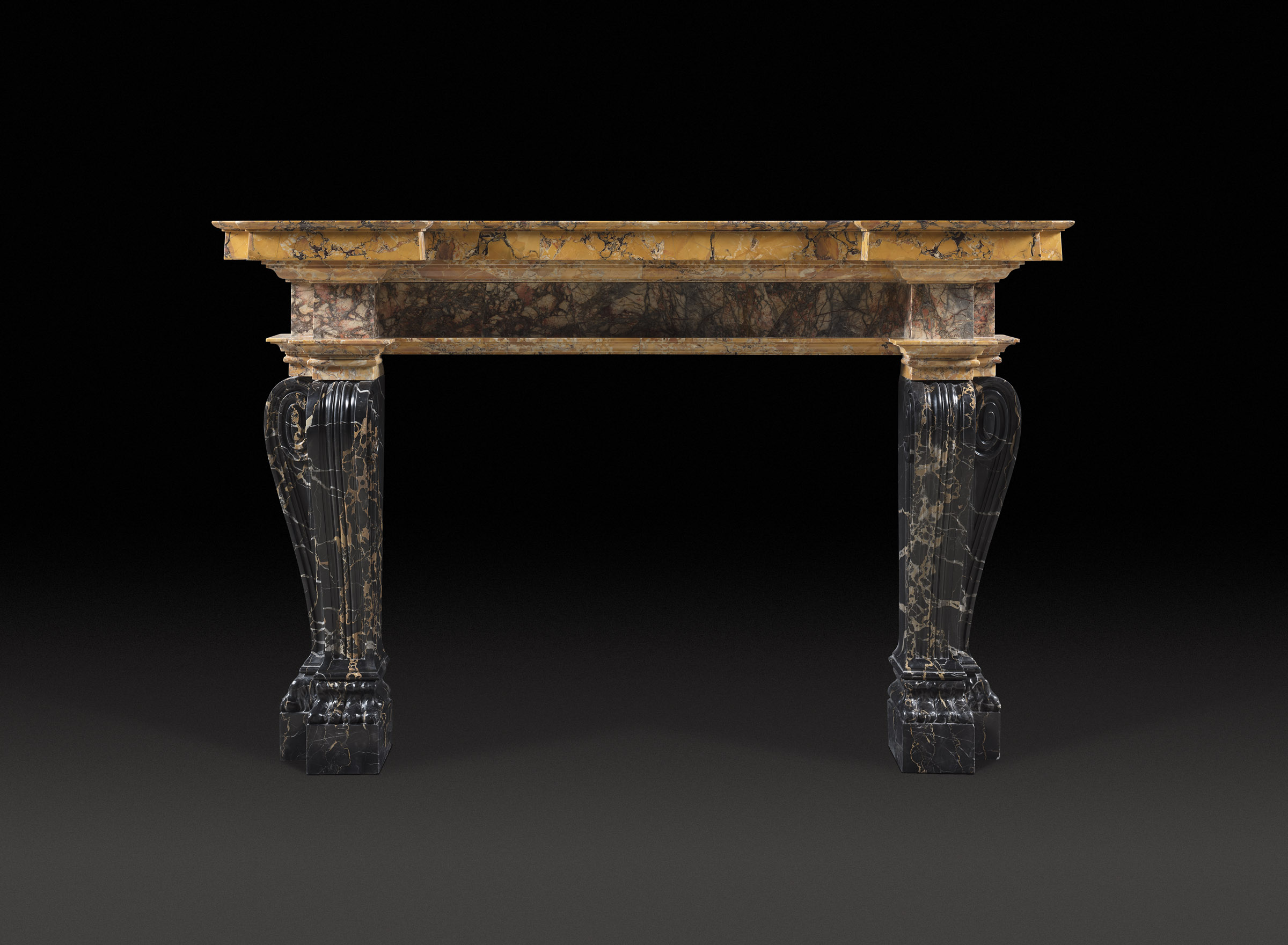
G430
A Giallo di Siena, Africano and Portoro Nero Marble Chimneypiece, Rome, 16th Century
No doubt originally intended for a palatial interior, this elegant chimneypiece is carved in three different specimens of prized coloured marbles: yellow Marmo Giallo Siena, a favourite of the Medici Grand Dukes in Florence; black Marmo Portoro veined with gold, from quarries near Portovenere overlooking the Ligurian Sea; and mottled red Marmo Africano, a stone first imported from Asia Minor in the time of the Roman Republic. Thanks to the Ancient Romans’ passion for coloured marbles, cities and town across the Italian peninsula – prime amongst them Rome – enjoyed a bounty of pietre dure, which were extracted from ancient ruins and duly reused, alongside more recently quarried specimens, to adorn the palatial residences of Renaissance popes and princes. One standout example of this fashion is the Villa Farnesina in Rome, built by the stupendously wealthy Sienese banker Agostino Chigi between 1506 and 1510 as a suburban retreat from his duties at the papal court.
Frescoed by artists of the calibre of Raphael and Sebastiano del Piombo, the Villa also boasts a rich array of coloured marble furnishings, pilasters, columns, door frames, floor slabs, and fireplaces, where the warm tonalities of Giallo di Siena are often contrasted with the darker ones of Marmo Africano, in a colour combination similar to that of the present chimneypiece. A pietre dure fireplace designed by the sixteenth-century architect Giacomo Barozzi da Vignola for the Salone di Ercole in Palazzo Farnese, the palace commissioned by future pope Paul III in the heart of Rome in 1515, further illustrates the use of coloured marbles in Renaissance interiors, a tradition that gradually extended to other European courts and, with the age of the Grand Tour, reached Britain.
The decoration of the jambs in the Vignola fireplace for Palazzo Farnese, with lion paws, scrolled volutes on the sides and female herms on the front, has its roots in a characteristic sixteenth century design, which also constitutes the basis for the present chimneypiece and was immortalised in Sebastiano Serlio’s highly influential Libro d’Architettura. A Marmo Cipollino fireplace in the patrician Palazzo Della Valle in Rome (c. 1525–34), a Marmo Giallo di Siena one in the papal fortress at Castel Sant’Angelo (1545–46), and a Pietra Serena one by architect Bartolomeo Genga for the Palazzo Ducale in Pesaro (1551–55), represent contemporary variations on the same design, which further evolved with the introduction of double carved jambs. The lasting legacy of this type of fireplace can be traced all the way to England, in the work of celebrated architects and sculptors such as Inigo Jones (1648, Double Cube Room, Wilton House, Wiltshire), John Michael Rysbrack (c. 1729, Marble Hall, Clandon Park, Surrey) and William Kent (c. 1730, Marble Parlour, Houghton Hall, Norfolk); as well as in other stately homes such as Holkham Hall in Norfolk and Kirtlington Park in Oxfordshire.
With its majestic proportions and its decorative emphasis on the patterns and colours of the marbles used rather than ornamental detail, the present chimneypiece belongs to the Renaissance tradition embodied by the interiors of the Villa Farnesina and by the coloured marble fireplaces in Palazzo Farnese, Palazzo Della Valle and Castel Sant’Angelo. Certainly carved in Italy and most likely in Rome, where stonemasons specialising in pietre dure had their workshops, our fireplace can be dated between the seventeenth and eighteenth centuries, when this type of design enjoyed significant popularity, including among British Grand Tourists, who regularly commissioned in Italy furnishings for their town and country residences back home. It is interesting to note that the slabs of colour marble in the present fireplace are backed with tuff stone, which is characteristic of Italian production up to the eighteenth century, further confirmation of our chimneypiece’s origin.
Like the fireplace in Castel Sant’Angelo, ours bears no surface decoration or ornamental carving – with the exception of the volutes in the jambs and the lions paws – a decorative restraint shared to varying degrees by other sixteenth and early seventeenth century examples, which contrasts with the more ornate nature of later fireplaces.
Height 54in (137cm) width 84¼in (214cm)
Internal height 40½in (103cm) width 53⅛in (135cm)
Footblock to footblock 73½in (187cm)
Shelf depth 13⅜in (34cm)






